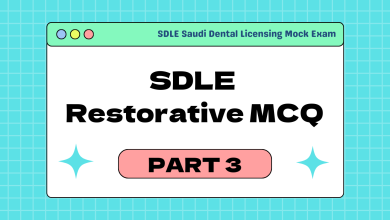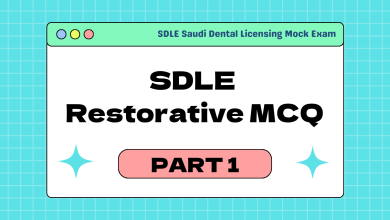Restorative SDLE MCQ | Part 2

The Ultimate Guide to Conquering the SDLE: Your Strategic Blueprint for Success
Preparing for the SDLE exam is a significant milestone in every aspiring dentist’s career. It’s more than just a test of memorized facts; it’s a comprehensive assessment of your clinical judgment and deep understanding of various dental specialties. Many candidates feel overwhelmed by the vast amount of information, unsure of where to start or how to focus their efforts efficiently.
This in-depth guide is designed to be your roadmap. We will walk you through proven, strategic steps to build a robust study plan, choose the right topics, and approach the exam with the confidence needed to excel.
Part 1: The Art of Smart Topic Selection
One of the most common pitfalls in exam preparation is trying to learn everything at once. A strategic approach to selecting your study topics is not just helpful—it’s crucial for efficient and effective learning.
Why is Topic Selection a Game-Changer?
Your study time is your most valuable resource. Without a clear plan, you can easily spend hours on low-yield information while neglecting the foundational concepts that form the core of the exam. Intelligent topic selection ensures that every hour you invest brings you a higher return in knowledge and exam readiness.
Your Step-by-Step Strategy to Begin:
-
Start with Diagnosis in Every Major Subject.
Before diving deep into complex procedures, ground yourself in the diagnosis for each core specialty: Restorative (Resto), Endodontics (Endo), Prosthodontics (Pros), and Periodontics (Perio). This approach is powerful because it builds critical connections between the subjects. Since most exam questions are clinically-based, understanding how to diagnose a problem is the first and most essential step toward finding the correct solution. You’ll start to see the “big picture” of patient care. -
Identify and Master the Foundational Topics.
Every specialty has a set of fundamental principles that appear again and again. Your initial goal is not to become an expert in every rare condition, but to achieve complete mastery over these core topics. Think of it as building a strong skeleton; once that is in place, you can easily attach more detailed knowledge.
Part 2: Your Detailed Study Blueprint: What to Focus On
The SDLE exam is designed to test your basic knowledge, which means it consistently draws from a predictable set of high-yield topics within each specialty.
A Deep Dive into Key Specialties:
1. Restorative Dentistry
-
Diagnosis: The ICDAS System (International Caries Detection and Assessment System) is paramount. You must know it inside and out.
-
Classifications: Be thoroughly familiar with cavity classifications (Black’s, etc.).
-
Amalgam: Understand its phases, types of failures, and preparation design principles.
-
Partial Coverage: Differentiate clearly between inlays and onlays, including their indications and preparations.
Understanding ICDAS: A Practical Guide
ICDAS provides a standardized method for assessing caries. Here is a clear breakdown:
| Code | Description |
|---|---|
| 0 | Sound tooth surface |
| 1 | First visual change in enamel (seen only after drying) |
| 2 | Distinct visual change in enamel |
| 3 | Localized enamel breakdown without visible dentin |
| 4 | Underlying dark shadow from dentin |
| 5 | Distinct cavity with visible dentin |
| 6 | Extensive distinct cavity with visible dentin |
2. Endodontics
-
Diagnosis: Master pulp testing, percussion, palpation, and radiographic interpretation.
-
Materials: Know the composition, pH, and side effects of key materials like irrigants and sealers.
-
Surgical Procedures: Understand the indications and steps for an apicectomy.
-
Regeneration: Be clear on the indications and materials used in regenerative endodontics.
-
Files: This is a favorite area for examiners. Learn the colors, cross-sections, and specific properties of different file systems, especially hand files like K-files and H-files.
-
Rotary Systems: Understand the basic principles and safety protocols.
3. Periodontics
-
Diagnosis: Be fluent in both the old and new (2017) classification systems for periodontal diseases.
-
Probes: Know the different types of probes and their specific markings.
-
Periodontal Diseases: Understand the etiology and characteristics of gingivitis and various forms of periodontitis.
-
Instruments: Identify and know the uses of scalers, Gracey curettes, and water irrigation systems.
-
Maintenance: Understand the protocols for supportive periodontal care and re-evaluation.
Part 3: Mastering the Question Bank: A Strategic Tool, Not a Crutch
Many candidates use question banks, but few use them optimally. The key is to approach them after you have built a strong foundational knowledge.
How to Truly Leverage Old Questions to Your Advantage:
-
Look for Recurring Patterns. As you go through question sets, you will start to notice that certain topics are tested repeatedly. These are your high-yield areas. Keep a log of these topics and ensure you know them cold.
-
Study the Topic, Not Just the Question. Don’t just memorize the answer to a specific question. When you encounter a question about, for example, “Wharton’s tumor,” don’t just note that the answer is the submandibular gland. Instead, open your textbook and read the entire section on salivary gland tumors. This transforms a single question into a comprehensive learning session.
-
Always Cross-Reference with Reliable Sources. Your primary sources of information should be standard textbooks and current scientific literature. Use the question bank to identify gaps in your knowledge, and then fill those gaps with authoritative material.
-
Take Notes on Every Answer Choice. When reviewing a question, don’t just look at the correct answer. For every incorrect option, write down a brief note explaining why it is wrong. This active learning technique forces you to cover a much broader scope of information and deepens your understanding significantly.
-
Learn from Colleagues. Connect with peers who have recently taken the exam. They can provide valuable insights into the exam’s focus and atmosphere. However, filter this advice—everyone’s experience is subjective.
-
Answer Questions on Your Own First. Resist the temptation to immediately look at the answers. Challenge yourself to reason through the question independently. This builds critical thinking and problem-solving skills that are essential for the exam.
Part 4: Demystifying Exam Difficulty and Building Confidence
It’s natural to feel anxious, especially when you hear stories about “impossible” questions. Let’s reframe that thinking.
Are All the Questions Difficult? Absolutely Not.
Any well-constructed exam has a mix of easy, moderate, and difficult questions. The difficult ones are typically a small percentage, while the bulk of the exam consists of questions of easy to moderate difficulty. The psychological trap is that our brains tend to remember and talk about the challenging questions we faced. This creates a false impression that the entire exam was overwhelmingly hard.
The Takeaway: Don’t let post-exam stories from colleagues panic you. If you find a subject challenging, go back and solidify your basic understanding in that area. A strong foundation will allow you to confidently answer the majority of the questions.
Part 5: Essential Mindset and Final Takeaways for Success
Your preparation isn’t just about intellectual knowledge; it’s also about the right mindset and habits.
Your Success Mantra:
-
Invest Your Time Wisely. The exam is challenging but passable for those who are well-prepared. Consistent, focused study is an investment that will pay off immensely, not just for the exam but for your clinical career.
-
Rethink Study Groups. Avoid using study groups for initial learning. They often become inefficient social sessions. However, they can be excellent for final revision, quizzing each other, and discussing complex topics after you have done your individual studying.
-
Build an Unshakeable Foundation. Prioritize depth over breadth in your core subjects. A deep understanding of fundamental principles will allow you to deduce answers to questions you may not have directly studied.
-
Aim for Mastery, Not Just Passing. Go into the exam with the goal of truly understanding the material. This mindset shift reduces anxiety and fosters a more profound, long-lasting knowledge that will serve you far beyond the exam hall.
Examples of Restorative SDLE MCQ
1. For a composite restoration with 0.5 mm of remaining dentin, what should be placed?
Answer Choices:
A. Calcium hydroxide
B. GIC
C. Zinc Oxide Eugenol (ZOE) cement
D. Dentin bonding system only
Correct Answer: D. Dentin bonding system only
Explanation: When only 0.5 mm of dentin remains, a dentin bonding system alone is sufficient. It provides effective sealing and adhesion without the need for additional liners, making it the most appropriate and minimally invasive option.
2. A patient drinks soda and soft drinks every day. What type of non-carious dental lesion would be found?
Answer Choices:
A. Erosion
B. Abrasion
C. Abfraction
D. Attrition
Correct Answer: A. Erosion
Explanation: The acids in sodas and soft drinks chemically wear away tooth enamel, a process known as erosion. This is distinct from abrasion (physical wear), abfraction (stress-induced lesions), or attrition (tooth-to-tooth wear).
3. What is the main composition of dentin?
Answer Choices:
A. Non-organic material (Hydroxyapatite)
B. Collagen fibers
C. Water
D. Cellular content
Correct Answer: A. Non-organic material (Hydroxyapatite)
Explanation: Dentin is primarily composed of hydroxyapatite, an inorganic mineral. This gives dentin its hardness, though it contains less mineral content than enamel.
4. When should you select the shade for a composite restoration?
Answer Choices:
A. Before rubber dam application
B. After rubber dam application
C. After cavity preparation
D. After etching
Correct Answer: A. Before rubber dam application
Explanation: Shade matching must be done before placing a rubber dam because the dam can dehydrate the tooth, making it appear lighter and leading to an inaccurate shade selection.
5. What is the primary function of a silane coupling agent?
Answer Choices:
A. To bind to porcelain and tooth
B. To strengthen enamel
C. To reduce sensitivity
D. To prevent caries
Correct Answer: A. To bind to porcelain and tooth
Explanation: Silane acts as a chemical intermediary, creating a strong bond between the inorganic porcelain surface and the organic resin of the cement or composite material.
6. What is the management for an amalgam restoration that has an overhang?
Answer Choices:
A. Remove and do another restoration
B. Scaling and root planing (SRP)
C. Finishing and polishing
D. Monitor and observe
Correct Answer: A. Remove and do another restoration
Explanation: An amalgam overhang promotes plaque accumulation, gingival inflammation, and bone loss. The correct management is to completely remove the defective restoration and replace it with a properly contoured one.
7. Which material is most durable for a foundation restoration to support a crown on a badly broken-down molar?
Answer Choices:
A. Amalgam
B. Compomer
C. Composite resin
D. GIC
Correct Answer: A. Amalgam
Explanation: Amalgam is known for its superior strength, durability, and ability to withstand high biting forces, making it the material of choice for core build-ups in extensively damaged molars.
8. Why is it necessary to remove the smear layer during root canal treatment?
Answer Choices:
A. To enhance penetration of sealer
B. To make removal of the sealer easier if needed
C. To reduce postoperative pain
D. To prevent discoloration
Correct Answer: A. To enhance penetration of sealer
Explanation: The smear layer blocks the dentinal tubules. Removing it with chelating agents like EDTA allows the root canal sealer to penetrate deeply into the tubules, creating a superior fluid-tight seal.
9. Which instrument is used for sharpening angles in a Class II cavity preparation?
Answer Choices:
A. Chisel (Angle former)
B. Hatchet
C. Gingival trimmer
D. Spoon excavator
Correct Answer: A. Chisel (Angle former)
Explanation: An angle former, which is a modified chisel, is specifically designed to create and define sharp internal line angles and point angles in Class II cavity preparations.
10. What is used for powered (in-office) tooth bleaching?
Answer Choices:
A. Polyacrylic acid
B. Hydrogen peroxide
C. Carbamide peroxide
D. Sodium perborate
Correct Answer: B. Hydrogen peroxide
Explanation: In-office power bleaching procedures typically use high-concentration hydrogen peroxide gels, which are often activated by a special light or laser to accelerate the bleaching process.
11. What is the management if a dentist accidentally exposes the pulp while removing a large carious lesion?
Answer Choices:
A. Direct capping
B. Put MTA immediately
C. Indirect capping
D. RCT treatment
Correct Answer: A. Direct capping
Explanation: For a small, accidental exposure in a healthy pulp, direct pulp capping with a biocompatible material like calcium hydroxide or MTA is the standard treatment to preserve pulp vitality and promote healing.
12. A patient has a gold onlay and experiences throbbing pain, with an opposing amalgam restoration. What is the likely cause?
Answer Choices:
A. Galvanism from opposing amalgam
B. High occlusion
C. Cracked tooth
D. Irreversible pulpitis
Correct Answer: A. Galvanism from opposing amalgam
Explanation: Galvanic pain occurs when two dissimilar metals (like gold and amalgam) come into contact through saliva, creating an electric current that can cause sharp or throbbing pain.
13. For a low caries risk 9-year-old child in for a recall visit, how many bitewing X-rays are needed?
Answer Choices:
A. One panoramic and two bitewings
B. Two periapical and two bitewings
C. No need for x-ray
D. Four bitewings
Correct Answer: C. No need for x-ray
Explanation: According to radiographic guidelines, for a low-caries-risk patient with no clinical signs of decay, no new X-rays are indicated during a routine recall appointment.
14. What type of cement should be used for luting a fiber post?
Answer Choices:
A. Resin cement
B. GIC
C. Zinc phosphate
D. ZOE
Correct Answer: A. Resin cement
Explanation: Resin cement is ideal for fiber posts because it bonds adhesively to both the dentin of the root canal and the post surface, creating a strong “monoblock” effect that enhances retention and reduces the risk of root fracture.
15. What is the best material for restoring a Class V cervical caries lesion?
Answer Choices:
A. Macrofill composite
B. Hybrid composite
C. Flowable composite
D. Amalgam
Correct Answer: C. Flowable composite
Explanation: Flowable composites have low viscosity, allowing them to adapt better to the often shallow and irregular margins of Class V cervical lesions. This improves the marginal seal and reduces microleakage.
Conclusion: Your Journey to Success Starts Now
The path to SDLE success is a marathon, not a sprint. It requires careful planning, disciplined execution, and a positive, resilient mindset. Start by strategically selecting your topics, build your knowledge layer by layer, and use practice questions as a diagnostic tool to refine your understanding.
Remember, confidence is born from competence. Every well-understood topic, every mastered concept, and every strategically studied hour brings you closer to your goal.
You have the capability and the resources to excel. Trust your preparation, stay focused on your plan, and walk into the exam ready to demonstrate your knowledge. Good luck





